Why trade supports rather than hinders sustainable development
- Introduction Executive summary | Positions of economiesuisse
- Chapter 1 Sustainable development includes several dimensions
- Chapter 2 International trade is a prerequisite for sustainable development
- Chapter 3 How Swiss business contributes to sustainable development
- Chapter 4 Effective instruments in the field of sustainability from a Swiss perspective
International trade is a prerequisite for sustainable development
In its 2030 Agenda for sustainable development, the UN made clear that business plays a central role in achieving sustainable development goals. In its view, international trade is a driving force for inclusive economic growth, poverty reduction and the promotion of sustainable development.
However, as trade is a broad concept, it includes an exchange of a wide range of goods (imports and exports). It serves both the production of new goods and their consumption, thus creating important benefits for people. But it is by no means limited to material things. It also includes foreign direct investment and the cross-border provision of services, for example when Swiss specialists repair a machine in another country or advise foreign companies on risk insurance.
Import and export of goods increases prosperity
The exchange of material and immaterial goods increases the prosperity of all countries involved, as each trading partner will only produce what it can do best in relative terms. This specialisation of individual countries leads to an international division of labour: goods are imported when their domestic production is too expensive. On the other hand, goods are exported if their production at home is cheaper than abroad. Imports also increase the choice of goods at home and lower prices for consumers. And exports have a positive effect on employment. This increases the income of the local population. The import and export of goods thus increases the overall prosperity of all trading partners involved. As a result of the global trade in goods and services, local companies are also integrated in international value chains.
Increased trade stimulates competition and thus progress
The specialisation of countries means that certain sectors of the economy are increasingly exposed to greater competition, including from abroad. Individual domestic suppliers may be forced out of the market as a result. Nevertheless, the long-term effects of increased competition are generally positive. Companies are forced to undergo a constant process of renewal. The resulting improvements in production processes not only disrupt existing structures, but also drive economic and technical progress in the market. As a result, particularly innovative domestic suppliers are successful and, thanks to technological and methodological advances, are able to establish themselves in the market, thereby increasing their productivity. This in turn generates additional revenues, which can eventually be redirected to new investments and ultimately create new jobs.
Foreign direct investment generates much more than just jobs
Global trade also includes foreign direct investment. This category of investment is made by Swiss companies with the intention of acquiring a lasting share in a company abroad. Foreign direct investment has both direct and indirect effects. For example, a direct effect is generated when a company opens a branch abroad, employs staff locally and pays their wages. A number of studies have shown that foreign companies in developing and emerging countries tend to pay higher wages than domestic ones.
Foreign direct investment has an indirect impact via so-called spillover effects, also known as externalities. In the case of spillover effects, certain influencing factors (such as the production or consumption of goods) have positive or negative effects on other factors. A positive spillover effect occurs, for example, when a Swiss company trains employees abroad, thereby increasing local knowledge about more efficient production methods. At the same time, air pollution caused by a factory abroad represents a negative spillover effect. In both cases, the advantages or disadvantages are not accounted for in the price, which is why they are external.
Positive structural effects of direct investment
The figure below shows the four different types of spillover effects foreign direct investment can have. For example, foreign companies can bring new technologies and knowledge to a country (knowledge transfer). This increases the productivity of the local economy. Foreign companies can also train employees, who then move to local companies in the target country (labour mobility). New market entrants also increase competition, which in turn increases productivity and efficiency in the market. In addition, the influx of foreign companies makes it easier for domestic firms to access export markets because they can use the infrastructure and networks of foreign companies for their own purposes.
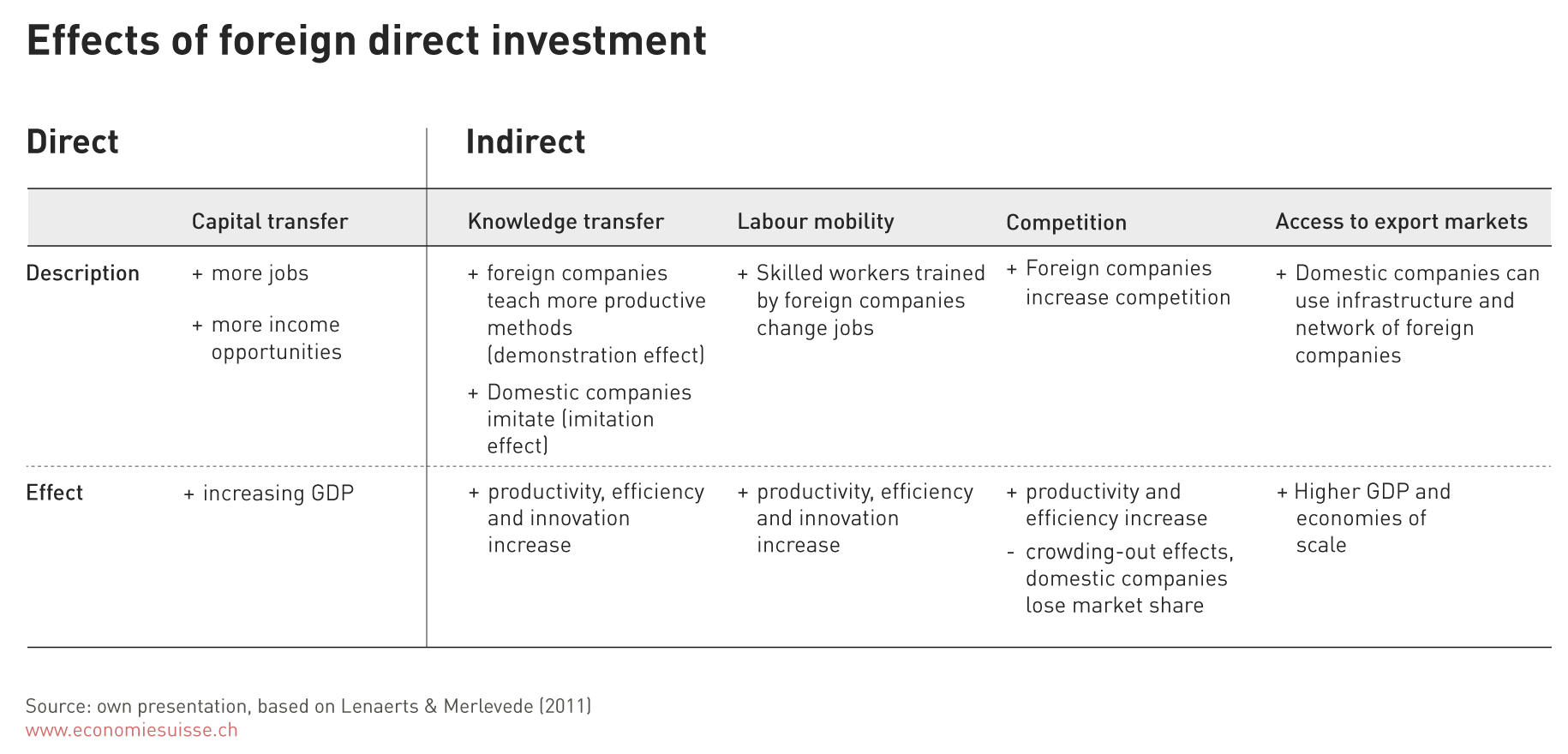
Foreign direct investment also facilitates the integration of local companies in international value chains. Thanks to positive spillover effects, even companies that act as suppliers or customers of foreign subsidiaries benefit.
Economic dimension: Open markets reduce poverty
Kofi Annan, former UN Secretary-General, once said: "Open markets offer the only realistic hope for lifting billions of people in developing countries out of poverty while maintaining prosperity in the industrial world". He firmly believed that the cause of poverty and underdevelopment is not too much trade, but too little trade, and therefore always advocated the dismantling of trade barriers. Science confirms this statement: open markets and trade have a positive effect on a country’s economic development. For example, they directly increase per capita GDP growth, equity investment and productivity. They also reduce structural unemployment and thus poverty.
Worldwide, the proportion of people affected by extreme poverty has fallen sharply in recent decades. Whereas, in 1981, 42.5 percent of all people lived in extreme poverty, this figure dropped to just 9.2 percent in 2017 (see figure below). Thus, the global poverty rate in 2017 was lower than ever before. For 2019, the global poverty rate is predicted to fall to 8.2 percent. Since the early 1990s, a total of more than one billion people has been lifted out of poverty.
At the same time, the share of trade in global economic growth has increased significantly since 1980. Between 2000 and 2018, the value of the exports of the least developed countries has increased more than six-fold (from 41 to 257 billion USD).
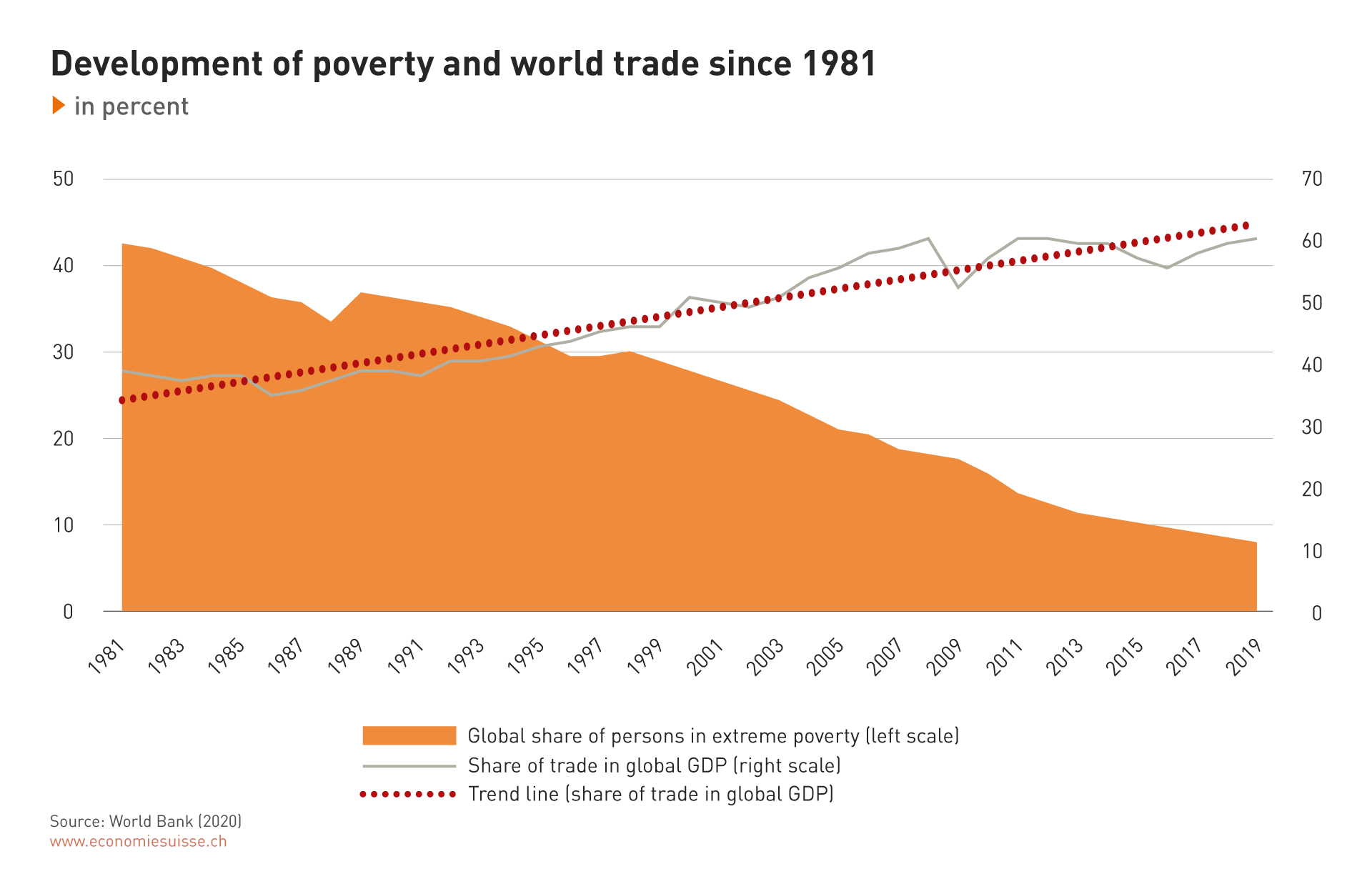
Trade plays a crucial role in poverty reduction. A study on African countries shows that trade openness and the structural change it triggers reduce poverty in the longer term and that the private sector contributes significantly to poverty reduction. The World Bank and the World Trade Organisation (WTO) draw the same conclusion: the expansion of international trade and the growth stimuli, productivity gains and income increases resulting from it are essential to reducing poverty worldwide. In 2018, the organisations published a joint report that provides eight case studies to show in concrete terms the contribution of trade to poverty reduction in developing countries. According to a World Bank study, per capita GDP in a country increases by one percent if its integration in global value chains increases by one percent.
Social dimension: Market openness increases the quality of life
Furthermore, open markets have predominantly positive effects on social sustainability. They increase the population’s access to education, especially for women. In addition, market openings go hand in hand with greater participation of women in the labour market and reduce child labour. Since 1990, life expectancy in the least developed countries has risen by an average of 13 years and the global mortality rate of children under five years has fallen by almost 60 percent.
The social aspects are part of the Human Development Index (HDI), which measures the social progress of countries. Various studies have come to the same conclusion: there is a positive correlation between trade and HDI. For example, it has been found that an inflow of foreign direct investment has a positive effect on the development of the HDI in Africa. A look at developing countries since 1991 confirms this positive relationship: the stock of foreign direct investment has increased substantially in these countries, while the HDI has also developed positively in the same countries.
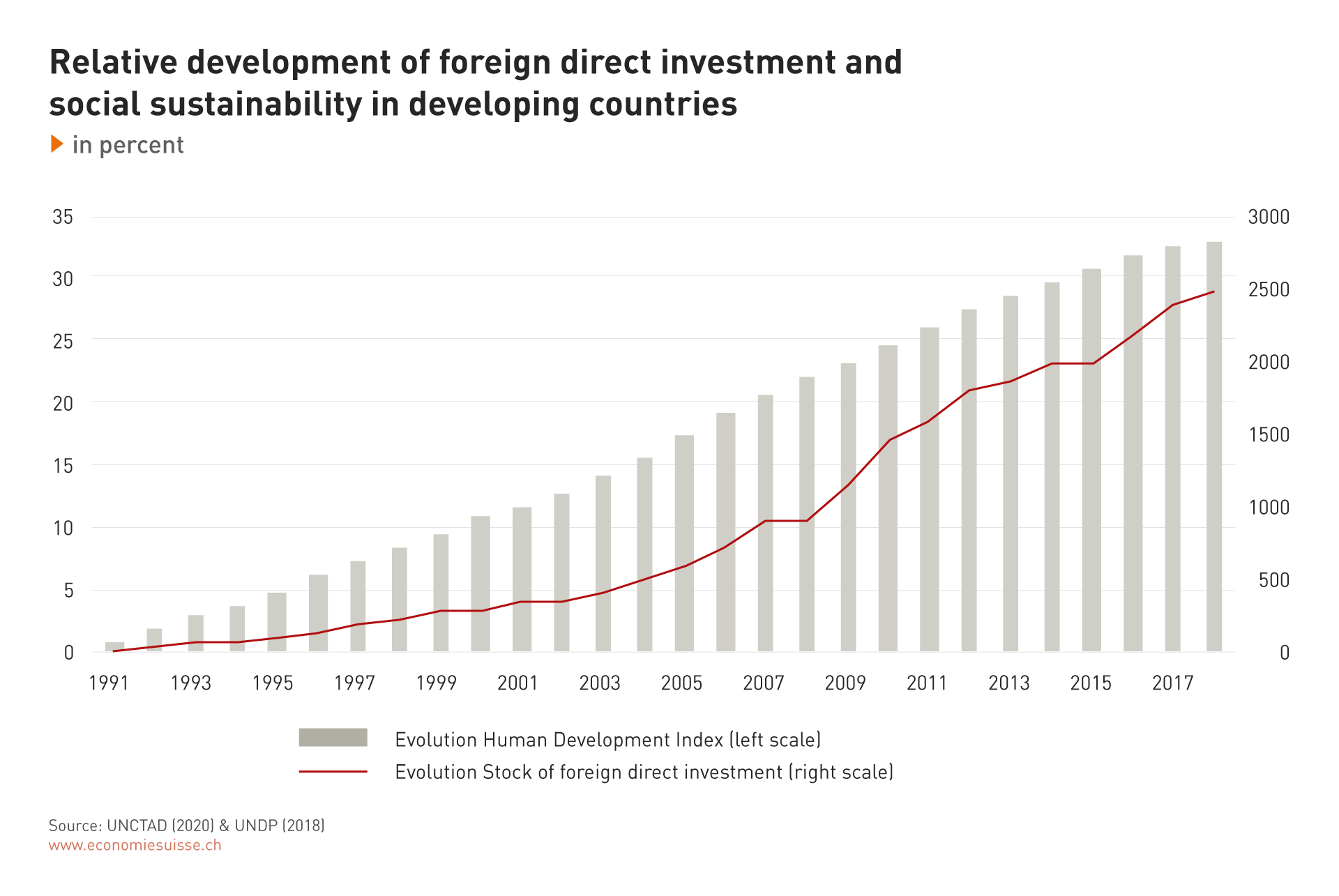
Environmental dimension: Mixed evidence on the environmental impact of trade
The impact of increased trade on environmental sustainability is disputed. Critics of free trade claim that developed countries take advantage of trade liberalisation to shift their environmental footprint to poorer countries with lower standards. According to evaluations by the ETH, however, this hypothesis cannot be empirically proven. On the contrary, liberalisation through free trade agreements does not cause a shift of the ecological footprint to low-income countries.
Another approach to determine the cause-effect relationship can be found in the Kuznets curve (see figure below). The curve describes the relationship between environmental quality and per capita income. In the initial phase of economic growth, the curve shows that pollutant emissions increase and environmental quality decreases. However, this happens only up to a certain level of per capita income. After that, the trend reverses, so that environmental quality improves as per capita income rises. The applicability of the Kuznets curve has been confirmed for various environmental aspects, such as water or air pollution and the ecological footprint.
Thus, in the short to medium term, trading can lead to an increase in CO2 emissions as production and consumption increase. Negative spillover effects, such as a market price that does not reflect the environmental costs of production or consumption, can occur. In the longer term, however, the new technologies introduced by trade will help to make local production more efficient and more resource-efficient (positive spillover effect). In addition, with rising income, the consumption patterns of the local population change as well – after all, people do not buy twice as many refrigerators just because they earn twice as much. Demand for more environmentally sustainable products, such as more efficient air conditioning systems, increases in the longer term and the need for an intact environment becomes more important.
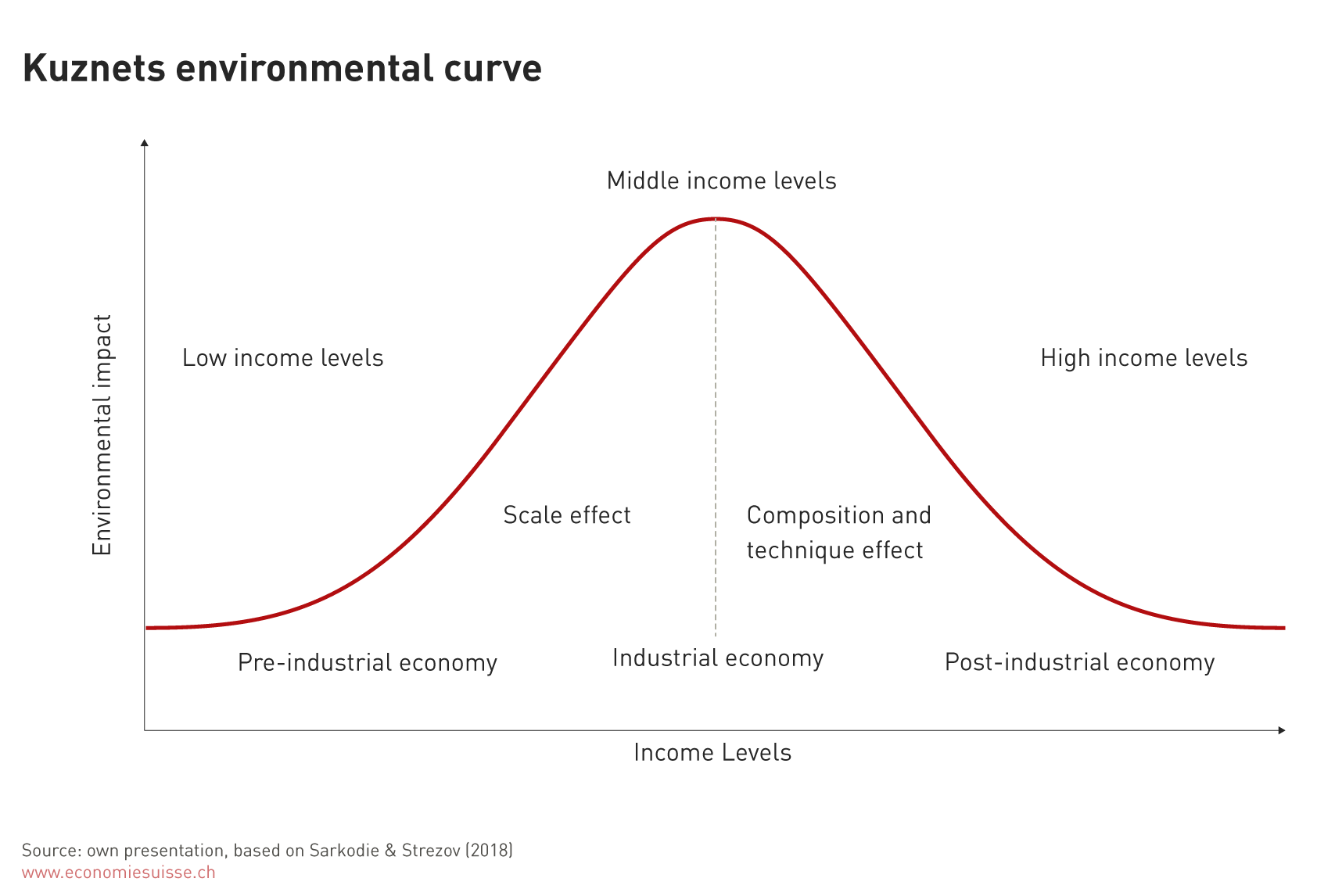
The economy is often not sufficiently considered when solving environmental problems, although pricing leads to more efficient production methods and new resources that can be tapped. A perfect example of this is the aluminium can which, in the 1950s, weighed 85 grams. Today it weighs only 13 grams. Thanks to innovation and recycling, it is now possible to save 85 percent of the material. Specifically, for industrialised countries with relatively high income levels, there seems to be a tendency to reduce the consumption of material. In Switzerland, per capita resource consumption has fallen by 30 percent since 1990, while economic output per person has increased by 25 percent.
Positive impact of trade is highly context-sensitive
The positive impact of trade on sustainable development along all three dimensions depends to a large extent on the context. This includes the design of legal and political institutions in the country, legal certainty, infrastructure, financial markets, education levels of the population, etc. It also depends on the extent to which foreign companies are embedded locally through their investments and how much they interact with local firms and stakeholders. Through the instrument of international cooperation, Switzerland endeavours to make a positive contribution in the areas of economic foundations, education and infrastructure in developing and emerging countries. However, despite some success, international cooperation is unable to fundamentally change a misguided policy in the local context or an unfair distribution of local wealth gains. Nor can international trade and the associated free trade agreements do so. Institutional reforms must come from within, i.e. they must be politically pursued and called for by the people and decision-makers in the country concerned. This is often a long and difficult process. It is not without reason that the 16th SDG, which includes, among other things, the promotion of inclusive institutions at all levels and the rule of law, is considered the most difficult to implement.
Market openings impact sustainable development via causal chains
In order to comprehensively assess the impact of trade on sustainable development, it is not enough to focus on individual aspects. The causal chains involved must be considered as well. For example, trade liberalisation can have a positive impact on different SDGs over several steps, as the example of a Swiss manufacturer in the figure below illustrates. The company has a programme that promotes women at its foreign branch according to the standards of the headquarters and thus makes a positive contribution to several UN sustainable development goals.
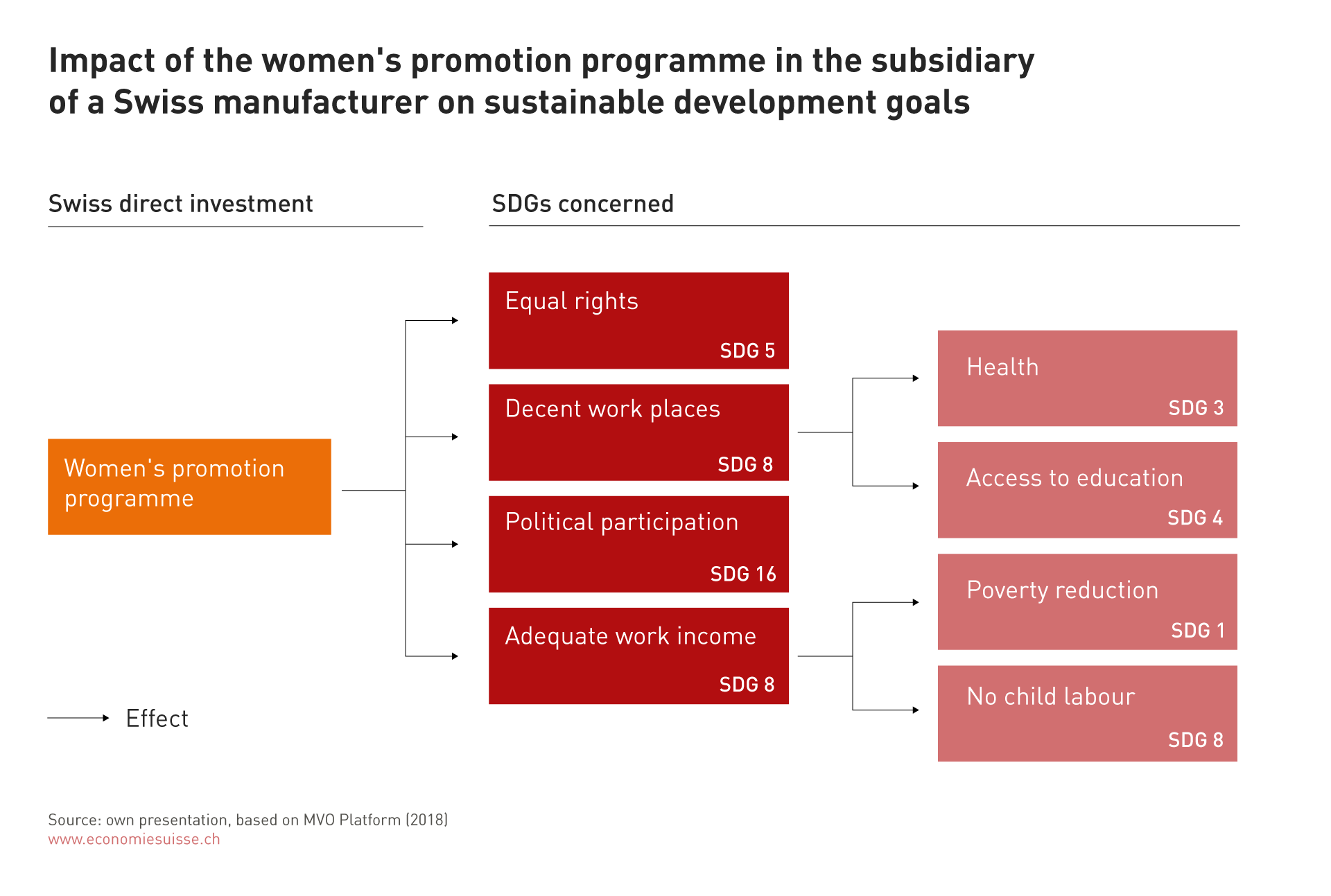
The timing and impact an effect has can vary as well. For instance, the effect can be negative in the short term, but positive in the long term. This can be seen in African countries, for example. There, parts of the local population may earn less after the market has been opened up because they do not yet have the skills that are now required. However, since the market opening also improves local training opportunities, this will change over the longer term and more local workers will benefit from the new jobs and thus increase their income.
Relevance of trade in services is increasing worldwide
The service sector plays a key role in the context of trade and sustainable development. In 2018, the value-based share of services trade in global trade was already 22 percent. And the opportunities for sustainability are great: trade in services promotes the transfer of knowledge, requires fewer natural resources than trade in goods, causes minimal environmental transport costs and thus generally leads to lower environmental pollution. It enables developing countries to integrate in very profitable global value chains and create highly productive jobs.
Innovation in sustainability thanks to digitalisation and commerce
Many sustainability problems can be solved through innovation. Innovation comes from smart talents and companies, not from the state. Trade is not just about goods, services or investments flowing into another country. It is also a means of exchanging ideas, experience, new technologies and knowledge. In addition, new contacts are made and cross-border networks are formed. Digitalisation serves as an important driver of innovation in the area of sustainability and significantly promotes the global transfer of knowledge. Coupled with political freedoms and open markets, society will in future be able to make even greater progress along all three dimensions of sustainability. This means that new inventions such as more efficient refrigerators or less energy-intensive cement production will become a reality in developing and emerging countries as well. Together with institutions that benefit everyone and the right economic incentives, such as patents, digitalisation and trade have incredible potential as drivers of sustainability.





